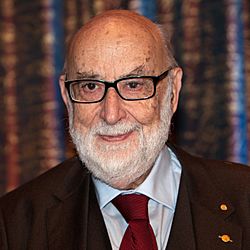François Englert facts for kids
Quick facts for kids
François Englert
|
|
|---|---|

François Englert, 2013
|
|
| Born | 6 November 1932 |
| Alma mater | Free University of Brussels |
| Known for | Higgs mechanism Higgs boson Spontaneous symmetry breaking |
| Awards | Francqui Prize (1982) Wolf Prize in Physics (2004) Sakurai Prize (2010) Nobel Prize in Physics (2013) |
| Scientific career | |
| Fields | Theoretical physics |
| Institutions | Université libre de Bruxelles Tel Aviv University |
François, Baron Englert (born 6 November 1932) is a Belgian theoretical physicist. He won the Nobel Prize in Physics in 2013.
Englert is a professor at the Université libre de Bruxelles (ULB). He is also a professor at Tel Aviv University and a member of the Institute for Quantum Studies. He received several awards for his work. These include the Wolf Prize in Physics in 2004 and the Sakurai Prize in 2010.
He is famous for his work on the Higgs mechanism. This idea helps us understand how tiny particles get their mass. He shared the 2013 Nobel Prize in Physics with Peter Higgs for this important discovery.
Contents
Early Life and Challenges
François Englert was born into a Jewish family in Belgium. During World War II, when Germany occupied Belgium, he had to hide his identity. He lived in different children's homes to stay safe. These towns were later freed by the US Army.
Becoming a Scientist
Englert studied at the Free University of Brussels. He became an electromechanical engineer in 1955. He then earned his PhD in physical sciences in 1959.
From 1959 to 1961, he worked at Cornell University in the United States. After that, he returned to the ULB in Belgium. He became a university professor there. In 1980, he led the theoretical physics group with his colleague, Robert Brout. Englert became a professor emeritus in 1998. He also started teaching at Tel Aviv University in 1984. In 2011, he joined Chapman University's Institute for Quantum Studies.
Understanding Particle Mass: The Higgs Mechanism
In 1964, François Englert and Robert Brout came up with an important idea. They showed how certain particles, called "gauge vector fields," could gain mass. This happens if empty space has a special structure. Imagine a magnet where all the tiny magnets inside are lined up. Empty space can have a similar hidden structure.
Particles that are affected by this structure can only travel a short distance. This means they have mass and create short-range forces. Particles not affected by this structure can travel freely. They remain massless and create long-range forces. This idea helped explain how both short and long-range forces can exist in one theory.
Later that same year, Peter Higgs and another team of scientists (Gerald Guralnik, C. R. Hagen, and Tom Kibble) also published similar ideas. All these papers were recognized as very important for understanding how particles get mass.
Englert, Brout, Higgs, and others suggested that a special field, often called the Higgs field, gives mass to fundamental particles. This mechanism is a key part of the electroweak theory. This theory helps us understand the basic laws of nature.
Major Awards and Honors
François Englert has received many important awards for his scientific work:
- 1982 Francqui Prize: He received this award for his work on how particles get mass. The prize also recognized his contributions to other areas of physics.
- 1997 High Energy and Particle Physics Prize: He shared this award for creating a theory about charged particles with mass. This theory became the basis for the electroweak theory.
- 2004 Wolf Prize in Physics: This award recognized his pioneering work on how particles gain mass.
- 2010 J. J. Sakurai Prize for Theoretical Particle Physics: He shared this prize for explaining how particles get mass in certain theories.
- 2013 Nobel Prize in Physics: He shared this highest honor with Peter Higgs. They were recognized for their theoretical discovery of the mechanism that explains the origin of mass in subatomic particles. This mechanism was later confirmed by experiments at CERN's Large Hadron Collider.
- 2013 Prince of Asturias Award: He received this award with Peter Higgs and CERN. It was for their theoretical prediction and experimental discovery of the Higgs boson.
In 2013, King Albert II of Belgium honored François Englert by making him a baron.
See also
 In Spanish: François Englert para niños
In Spanish: François Englert para niños
- List of Jewish Nobel laureates

